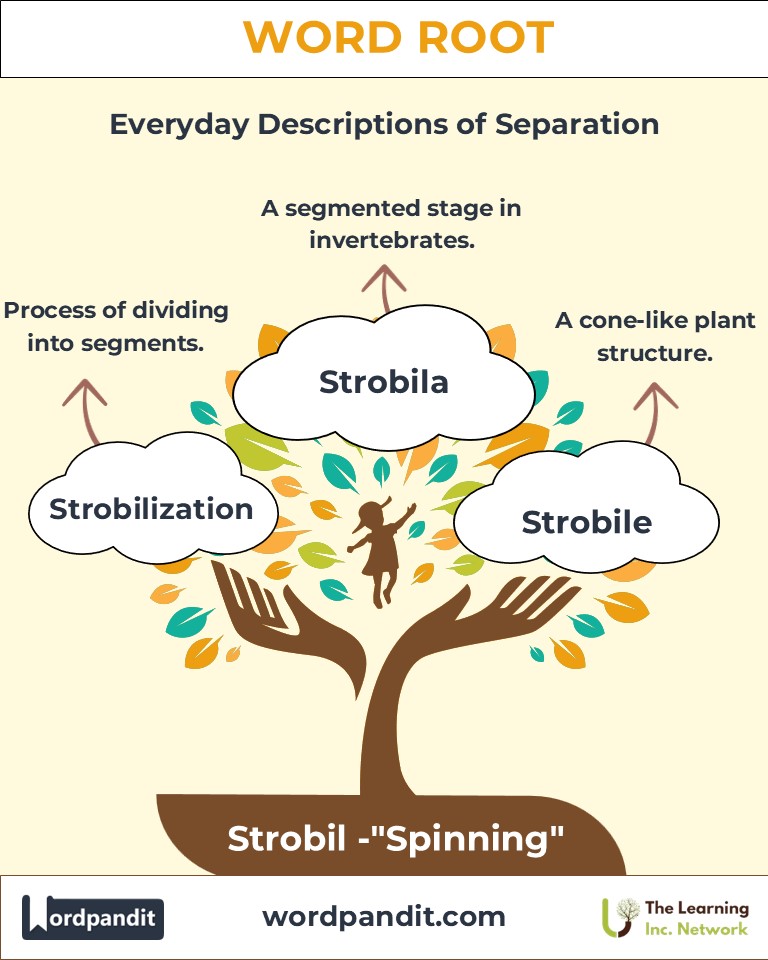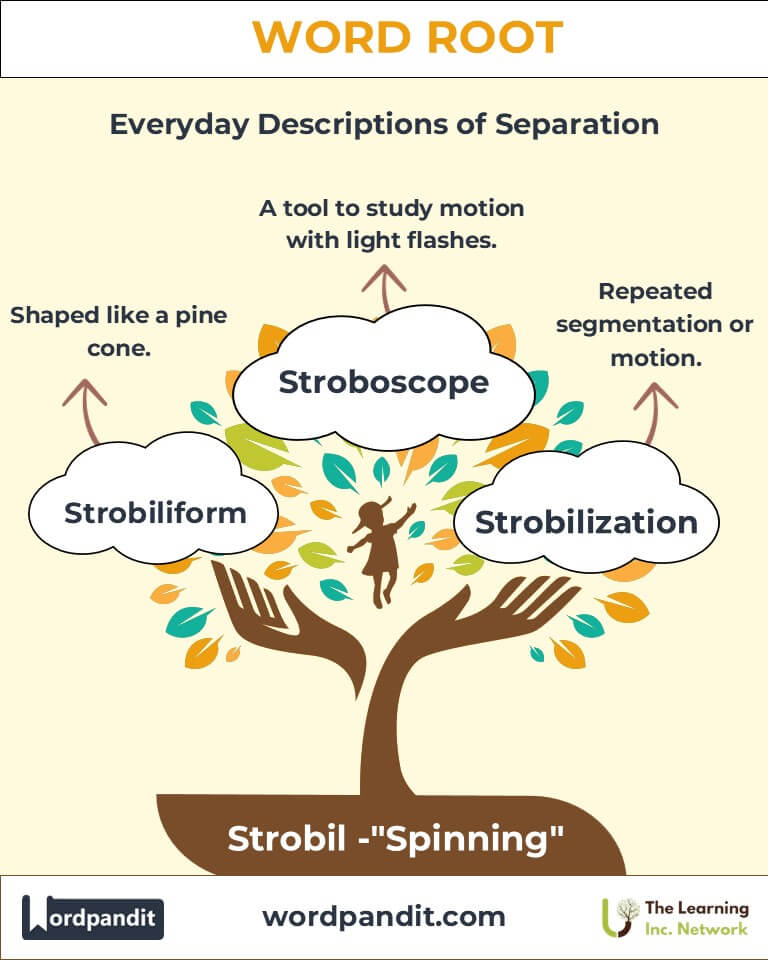Strobil: The Root of Spinning in Biology and Beyond
Discover the fascinating world of the root "strobil," derived from the Greek word for "spinning." This root forms the basis of words that describe structures or processes characterized by rotation or repeated segmentation, such as "strobila" and "strobilization." Explore its linguistic journey, scientific significance, and cultural impact in this comprehensive guide.

Table of Contents
- Introduction: The Essence of "Strobil"
- Etymology and Historical Journey
- Mnemonic: Unlocking the Power of "Strobil"
- Common "Strobil"-Related Terms
- "Strobil" Through Time
- "Strobil" in Specialized Fields
- Illustrative Story: "Strobil" in Action
- Cultural Significance of the "Strobil" Root
- The "Strobil" Family Tree
- FAQs about the "Strobil" Word Root
- Test Your Knowledge: "Strobil" Word Root Quiz
- Conclusion: The Enduring Legacy of "Strobil"
1. Introduction: The Essence of "Strobil"
From the spinning tops of childhood to the segmented bodies of certain animals, the concept of "strobil" resonates across disciplines. Pronounced strow-bil, this root originates from Greek, meaning "spinning" or "twisting." Found in words like "strobila" (a segmented larval stage of certain invertebrates) and "strobilization" (a biological process involving repeated segmentation), "strobil" connects language to natural phenomena and scientific processes.

2. Etymology and Historical Journey
The root "strobil" comes from the ancient Greek strobilos, meaning "whirl" or "twisting object," itself derived from strephein, "to twist." Ancient Greek philosophers used the term metaphorically to describe circular movements, and its adoption in biology reflects this original sense of rotation or segmentation.
3. Mnemonic: Unlocking the Power of "Strobil"
To remember "strobil," picture a spinning carousel with colorful, segmented panels whirling around. Each segment represents the recurring divisions that define strobil-related terms.
Mnemonic Device: "Strobil spins and segments, twisting the world into motion."
4. Common "Strobil"-Related Terms
- Strobila (strow-bye-luh): A stage in the life cycle of certain invertebrates, such as jellyfish, characterized by segmentation.
- Example: "The strobila of the jellyfish develops into individual medusae through strobilization."
- Strobilization (strow-bil-ih-zay-shun): A process where a polyp divides into segments that become free-swimming medusae.
- Example: "During strobilization, each segment matures into a new jellyfish."
- Strobile (strow-bile): A cone-like structure in plants or fungi, consisting of overlapping scales or segments.
- Example: "The strobile of the hop plant is essential for brewing beer."
- Stroboscope (strow-boh-skope): An instrument that creates the illusion of motion by flashing light at specific intervals.
- Example: "The stroboscope helped the scientists study the spinning turbine."
- Strobiliform (strow-bil-ih-form): Having a form resembling a pine cone or a strobile.
- Example: "The strobiliform arrangement of the seeds protects them from environmental damage."
5. "Strobil" Through Time
- Ancient Usage:
- In classical times, "strobilos" described spinning objects or whirlwinds, reflecting the natural world's fascination with circular motion.
- Modern Science:
- In the 18th and 19th centuries, biologists adopted "strobil" to describe segmented structures in living organisms, bridging the gap between natural patterns and scientific terminology.
6. "Strobil" in Specialized Fields
- Biology:
- Strobilization: Crucial for understanding the life cycles of jellyfish and tapeworms.
- Significance: This segmentation process allows for efficient reproduction and survival.
- Botany:
- Strobile: Refers to seed cones of coniferous plants and other similar structures.
- Application: Studied in agriculture for their economic importance in brewing and horticulture.
- Technology:
- Stroboscope: Used in engineering to measure rotation speed and analyze periodic motion.
- Impact: Facilitates advancements in mechanical diagnostics and motion studies.
7. Illustrative Story: "Strobil" in Action
In a quiet coastal town, marine biologist Dr. Elena observed the mesmerizing process of strobilization in jellyfish. Under her microscope, polyps divided into perfect, spinning segments, eventually transforming into tiny medusae. Inspired, she developed educational kits for schools, teaching children about nature’s intricate cycles using spinning strobil-like models.
8. Cultural Significance of the "Strobil" Root
From the swirling patterns of traditional dances to the segmented forms of architectural designs, "strobil" has inspired art and culture. Its connotations of rotation and renewal symbolize continuity and progress, appearing in literature and metaphors about life's cyclical nature.

9. The "Strobil" Family Tree
- Trop- (Greek: "turn"):
- Example: Tropism (movement in response to a stimulus).
- Rot- (Latin: "wheel"):
- Example: Rotation (circular movement).
- Seg- (Latin: "cut, divide"):
- Example: Segment (a part or division).

10. FAQs About " Strobil "
Q: What does "strobil" mean?
A: "Strobil" means "spinning" or "twisting," originating from the Greek word strobilos, which described whirling or circular movements. The root is used to convey rotation or segmentation in biological and technological contexts.
Q: What is strobilization?
A: Strobilization is a biological process where certain organisms, like jellyfish polyps, divide into repeated segments that eventually mature into free-swimming medusae. This process exemplifies the concept of spinning or recurring patterns in nature.
Q: What is a strobila?
A: A strobila is a segmented stage in the life cycle of certain invertebrates, such as jellyfish or tapeworms. Each segment represents an individual that will develop into a fully functional organism, demonstrating the root's meaning of division and rotation.
Q: How is "strobil" used in botany?
A: In botany, "strobile" refers to cone-like structures found in plants or fungi, like the seed cones of conifers or the hop cones used in brewing. These structures often exhibit overlapping scales or segments, embodying the idea of layered or rotational arrangements.
Q: What is the function of a stroboscope?
A: A stroboscope is a device that emits flashes of light at specific intervals to study motion. It creates the illusion of a stationary or slow-moving object by synchronizing the light's frequency with the object's movement, highlighting the spinning or rotational theme of "strobil."
Q: Can "strobil" describe objects outside biology?
A: Yes, "strobil" appears in technology and physics through terms like stroboscope, demonstrating its application in analyzing motion or segmentation in mechanical systems.
Q: What does "strobiliform" mean?
A: "Strobiliform" means having a shape or structure resembling a strobile (cone). This term is used in botany or other fields to describe layered, cone-like forms.
11. Test Your Knowledge: " Strobil " Mastery Quiz
1. What does "strobil" mean?
2. What is a strobila?
3. What is strobilization?
4. What device uses the principle of "strobil"?
5. What is a strobile?
12. Conclusion: The Living Legacy of "Strobil"
From biology to technology, "strobil" demonstrates the beauty of spinning and segmentation in nature and human innovation. Its presence in language and science reflects humanity’s curiosity and ingenuity, reminding us of the interconnectedness of all things. The legacy of "strobil" continues to spin new stories, discoveries, and inspirations.












